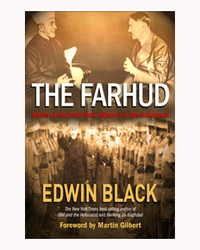The Farhud: Edwin Black's Exhaustive Research on Arab-Nazi Collusion
 |
Edwin Black's new book The Farhud: Roots of the Arab Nazi Alliance in the Holocaust should be required reading for anyone who wants to understand the Arab-Nazi alliance at the root of the conflict in the Middle East.
By Lyn Julius
Re-published by permission from Spero News
“This book is a nightmare... I regret that I was the one who had to write it. I hope it never becomes necessary to write another like this one.’ These are among the opening words to Edwin Black’s new book, Farhud.
 Edwin Black |
Much of Farhud does not make for comfortable reading. The central event is the two days of rioting in June 1941, resulting in the deaths of hundreds of Jews – the exact figure is not known - destruction of property, mass looting, rape and mutilation. Farhud is the Arabic name for ‘ violent dispossession’. The pro-Nazis who planned it, however, had a more ambitious and sinister objective in mind: the round-up, deportation and extermination in desert camps of the Jews of Baghdad.
The Farhud was the Iraqi Jews' Kristallnacht. Samuel Edelman, in an afterword to Black’s book, admits he had never heard of this terrible event until 2003. Yet, as Black shows, the Farhud cemented a wartime Arab-Nazi alliance designed to achieve a shared objective: to rid Palestine, and the world, of the Jews. The killing sprees by Arabs continued into North Africa and Balkans: the Germans raised five Arab batallions in Tunisia, Algeria and Morocco. Bosnian Muslims, personally recruited into SS divisions by the pro-Nazi Mufti of Jerusalem, entered into a grisly and murderous partnership with the Ustasha Catholic Croat nationalists to wipe out 100,000 Gyspies and Jews in Yugoslavia. After the war was over, the legacy endured: The mass exodus of the 140,000 Jews of Iraq followed a Nazi pattern of victimisation – dismantlement, dispossession and expulsion.
Black demonstrates clearly that the road to Baghdad begins in Jerusalem and Hebron in 1929, when Arabs massacred dozens of Jews. The immediate pretext was that Jews praying at the Western Wall wanted to sit on chairs. Arab Muslims considered Jews sitting an unbearable provocation: inferior dhimmis could only pray under the conditions dictated by Muslims. Not much has changed in the Middle East. Sadly, it only takes the rumor of a provocation to set off riots and book burnings.
The architect of the Nazi-Arab alliance was the Mufti of Jerusalem, Hajj Amin al-Husseini. One of Black’s best chapters describes how the Mufti muscled his way in to power by outfoxing the British. It comes as a revelation to discover that Amin al-Husseini only polled fourth in elections to the office of Mufti, with a paltry nine votes, and schmoozed the British High Commissioner Herbert Samuel over dinner into appointing him. The Mufti was an indefatigable founder of anti-Zionist societies, youth groups and committees, and craftily internationalized the Palestinian cause through Islamic conferences and institutions. His local opponents protested in vain at his corruption and Machiavellian politics: in 1925, they drew up a petition asking the British to rein in their man. Black shows how the Mufti sidelined and finally disposed of them in the Arab revolt of 1936 – 39.
Engineering more escapes in his lifetime than Houdini, the Mufti fled from the British to Baghdad. There he inspired the Golden Square pro-Nazi officer ring, making repeated attempts to throw off the pro-British government. They finally succeeded in May 1941, and seized power briefly until British forces managed to restore the Regent to Iraq. But the Golden Square’s parting shot was to wreak Farhud mayhem and murder among the Jews.
Black takes his time setting the scene, not sparing the reader the graphic details. Graphic detail is what Black does best, whether it be the barbarities of the Mongols who erected pyramids of severed heads, or the brutality of the British, who took a grueling 18 months to push from Basra to Baghdad in 1915, and cruelly suppressed an insurgency after their conquest of Iraq with gas bombs. He also surprises us with little known facts, such as the British post-World War l plan to transform Iraq into another India, to the point of transferring in thousands of Indian immigrants.
As with other Black books, Farhud is exhaustively researched – Black’s trademark technique is to deploy an army of data-gathering assistants in archives and libraries across the word. The footnotes and bibliography run to a whopping 150 pages. The book’s weakness, perhaps, is that Black’s insights at times get buried in a welter of information.
Eloquently-written, and always sustaining reader interest, Farhud begins by hurtling through 2, 500 years of Jewish history in Mesopotamia, the "cradle of civilization." It then bifurcates into a comprehensive account of Zionism and the Yishuv on the one hand, and the colonial politics of oil on the other. Here, Black is on familiar territory, charted in his two earlier bestsellers, Transfer Agreement and Banking on Baghdad. Black’s thesis is that these two factors explain two strands of Arab hatred, fusing into the Arab-Nazi axis.
The chapter on Zionism and pre-statehood is an excellent potted history of the struggle for a national home for the Jews. The tragedy is not that the Arabs rejected Zionism from the word "go," but that extremists peddling a dangerous brew of traditional Islamic antisemitism and admiration for rightwing fascism were allowed by the British to elbow out their moderate rivals and move into positions of power.
Black’s exposition of the geopolitics of oil may explain the Allies’ designs on Iraq for its black gold, but it is less convincing as an explanation of Arab hatred of the British. After all, Germany too had designs on Iraqi oil, but the Arabs were anxious to court Germany from the start.
Arab advances were not at first reciprocated. The pressures on Palestine created by Nazi antisemitism and the Transfer agreement to allow German Jews to emigrate were a source of Arab anger and frustration. Even after the Nazis had co-opted Arabs as honorary Aryans, the Germans viewed the alliance with the Arabs as "uneasy and contrived."
Black’s achievement is to show that a Arab-Nazi alliance not only took root, but went from strength to strength. The ‘politically-correct’ liberal establishment is at pains to deny it. In the preface, a bitter Black tells of his struggle to get the U.S. Holocaust Memorial Museum in Washington to recognize the Farhud as a Nazi event. Not only did they at first refuse to do so, but they wrote to other Holocaust museums asking them to do the same.
Revisionist academics (e.g. the School of Oriental and African Studies professor Gilbert Achcar) are also at pains to deny the Arab-Nazi alliance and downplay the role of the Mufti. They claim that the alliance was a temporary, pragmatic anti-colonial relationship built on the premise that ‘the enemy of my enemy is my friend ‘. There is also a contemporary trend to build interfaith dialog by highlighting the role of Arab individuals who saved Jews, while ignoring those who persecuted them.
That is why Edwin Black’s Farhud should be required reading for anyone who wants to understand the Arab-Nazi alliance at the root of conflict in the Middle East.
Lyn Julius is a journalist and founder of the London-based Harif, the Association of Jews from the Middle East and North Africa.
Edwin Black is a frequent contributor to The Auto Channel and is the author of "The Plan," "Internal Combustion," "IBM and the Holocaust," "Nazi Nexus," and "Banking on Baghdad."
Click PLAY to watch Edwin discuss his book "The Transfer Agreement" Part 1 of 5


